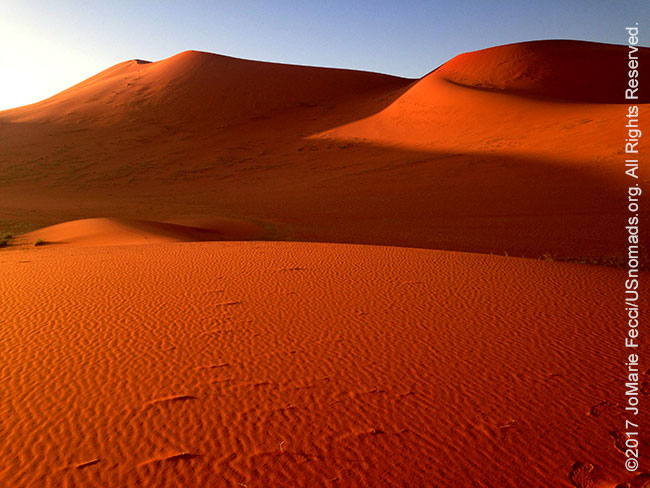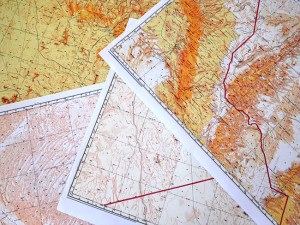
DJANET, ALGERIA — It’s always bizarre to arrive in a new place in the middle of the night. But the flights into Djanet all arrive around midnight. Not that there are so many flights arriving here these days — depending on the time of year there may only be a few flights a week to and from Algiers. Anyway, I was lucky enough to be on one, and smiled as I deplaned into the warm Saharan night. I walked across the tarmac to the small terminal at Tiska, where Algerian police were politely checking the papers of anyone who looked like they might be a foreign tourist. There were only a few of us. And one or two Algerians who looked “foreign” enough to be asked for their papers too — a humorous exchange took place between the Algerian men and the police (though it was in Arabic, and I couldn’t understand exactly what was said)… [read more]

EL BERDJ — TADRART, ALGERIA — We set off for the desert this morning. Though “set off for” is probably not the best way to say it since Djanet is actually already in the desert. In any case we covered a lot of miles, first on the highway, and then on sand. The highway drive was a straight shot on nicely paved tarmac surrounded by the Sahara’s vastness. We made a stop en route to deliver some food to a nomad camel herder, then passed the turnoff for the road to Niger, and took the direction of Libya… [read more]

WANTA BERKA — TADRART, ALGERIA — Last night we stayed up quite late, waiting for the full moon to rise over the canyon walls. It got pretty cold and we were bundled up and huddled close around the fire. The guys had their guitars out and were playing the desert blues of the tenere known as “assouf.” It is the musical style of the band Tinariwen and in fact they played a few songs from that group and other local bands, as well as just some of their own music and the ambiance was otherworldly with the flickering fire and the odd shadows of the strangely shaped canyon walls. When the moon finally peeked up over the edge, it thew so much light which reflected off the sand, making it bright enough that I could almost think it was morning… [read more]

INDJAREN — TADRART, ALGERIA — Dancing with camels this morning. Probably the same camels we saw yesterday in the dunes. We stopped to photograph them again, and Mohamed got out his drone to try to figure out how to use it. The whole moment was a bit surreal, as we had the music playing loud and Saghd started dancing in the middle of nowhere with the camels crossing on the other side while Mohamed tried to get the drone to fly… [read more]

TIN MERZOUGA — TADRART, ALGERIA — Exploring in the sand this morning I realized the black rocks we were walking on in some spots were actually the top of these walls and rock formations that had already been covered with sand. Dunes were forming on top of the rock, and we were driving on top of the dunes. Below us I could see exposed rock walls and formations in various stages of erosion. Some were partially covered by the sand. The realization that the eternal desert is itself truly ephemeral and constantly changing. The dunes move, the sand covers more rock, the rock itself crumbles and becomes sand. The only constant is the wind and even that apparently changes direction at different times of the year. The Sahara is complicated… [read more]

ADJALATI, ALGERIA — We started off the day in search of gazelles following faint tracks along the length of the erg Tin Merzouga near the Libyan border. Mohamed had seen some here once before and the terrain was wide open, so if we encountered some we could pace them for a while. There were lots of tracks but we saw no gazelles. Still, we enjoyed the chance to drive the open desert in a moment of true freedom. We had no real destination as we chased our phantom gazelles against a background of tall sand dunes and blue sky… [read more]

ERG ADMER, ALGERIA — It felt a bit strange to be back on pavement this morning, as if we were returning to modern civilization after spending almost a week suspended in the timelessness of the eternal desert. There was something sad about leaving the wonders of the Tadrart behind, and though I still have several more days in the region, I had the sensation that this is the start of the “return”… [read more]

DJANET, ALGERIA — I was up early, before dawn, and went for a walk on the dunes of Erg Admer while the light was still blue with only the first streaks of distant red signaling the approach of the sun. As I followed the contours of a dune with no particular destination in mind I realized how much I have learned about the desert since I began dreaming of a grand Sahara crossing five years ago. Today I stand here, deep in a remote south-eastern corner of Algeria, comfortably walking alone across a sea of sand dunes with no fear. I have risen to the desert’s challenges and am reaping its reward. The magnificence of this mix of eternal and ephemeral surrounds me and I bask in the present trying to stretch it out a little longer… [read more]

IHRIR, ALGERIA — We left Djanet early in the morning, after getting “lost” in a tangle of fenced-off desert where there didn’t used to be any fences on the outskirts of town. Apparently someone had sectioned off the land and was preparing it for agricultural use. This is something I also saw happening in Mauritania, and it confuses drivers who are used to being able to go in a fairly straight line from point to point. As there are no roads to follow, we had to drive around randomly looking for a way around the blocked area. Eventually a new piste will be worn in and the route will become clear, but for now it remains a puzzle… [read more]

ERG ADMER, ALGERIA — We said goodbye to Saghd’s aunt in the morning as she prepared to take out her goats and we left to return to the heights. The white pickups were still there, but no sign of the guys from last night, and we made our photos and moved on. I couldn’t get over how different the landscape was up here from the Tadrart and the surrounding desert. All the black rock everywhere, it was a completely different feel. And I realized there were no camels. Apparently this area is accessible by donkey rather than camel. I also remember hearing somewhere that camels do not like hills. Whatever the reason, it seemed like the first day without camels since I arrived… [read more]

TIKOBAWIN, ALGERIA — This morning we awoke to dusty skies. Suddenly the desert was rendered in pastels. The whole tone was different. And in the back of my head I started to worry about whether or not my flight would be able to take off in a few days time. If we were entering a period of dust storms the plane may not be able to fly, and there wasn’t another one scheduled for days. Oh well, there is nothing we can do about weather, Inshallah it will all work out… [read more]

DJANET, ALGERIA — Last night we had a late night of music under the stars, just savoring the moment. Of course for the guys it is different. They live here and can come back out to the desert any time they want to. I leave the Sahara tomorrow and it will be a long time before I can come back. This trip has been really special and even though we had stayed up late, I woke up very early and went for a walk by myself to explore the landscape of stone spires with sand dunes in between… [read more]

ALGIERS, ALGERIA — Today is a very long day of journey home. Last night after doing some errands in the market in Djanet I got to go back and do some more photography in the ksars, and we even got to visit the restored area, as Mohammed knew someone who worked for the association involved in preserving the location. He came and opened the locked gate for us and accompanied us, but we were free to explore and photograph all around the site. He told us a little history, and explained how the families from this ksar and the other one would consider each other as “outsiders,” so that if someone from the other ksar married into a family here, they would still be considered a “foreigner” in the community… [read more]

NEW YORK, USA — I arrived home to New York today, exhausted from the three flights and long layovers, but still feeling the magic of the tenere. And the Saharan sand is still in my boots, and probably everywhere else too — a small pile of desert fell out of the bottom of my duffle bag when I finished unpacking. It will take me a while to process everything from the trip, edit through the photos, organize the GPS tracks and map the routes, and put all my notes into a coherent report. That is all the longer, harder part of the project after the rush of the actual journey… [read more]
ABOUT THE EXPEDITION

JoMarie Fecci, of USnomads, sets off on an independent scouting trip in south-eastern Algeria in preparation for an up-coming Sahara expedition. Driving a Toyota Landcruiser and working with a small team of local Tuaregs, she will traverse roughly 650 miles of desert primarily off-road. From a base in the town of Djanet the plan is to loop southeast to the Libyan border, before turning back and circling north west as far as the Ihrir oasis. During the journey the team will visit a series of UNESCO world heritage sites around Tassili N’ajjer. The primary goal of this mission is to assess terrain, security, driving conditions, logistical concerns and approximate timeframes for future travel.
WHERE WE ARE

The People’s Democratic Republic of Algeria, in North Africa is the largest country in Africa and the tenth-largest country in the world. With an area of 2,381,741 square kilometres (919,595 sq mi) it is one-quarter of the size of the entire United States and four times the size of France. Its capital and most populous city is Algiers, located in the country’s far north on the Mediterranean coast. It is bordered to the northeast by Tunisia, to the east by Libya, to the west by Morocco, to the southwest by the Western Saharan territory, Mauritania, and Mali, to the southeast by Niger, and to the north by the Mediterranean Sea. With a population of roughly 38,813,722, Algeria ranks 33rd in population worldwide. The majority of that population, which is a well-integrated mixture of Arab and indigenous Berbers, live in the northern, coastal region. The official language is Arabic though many people also speak French and/or one of the nation’s Berber dialects.